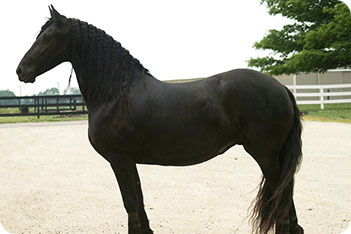
Horse Strangles
Equine Veterinary
From: Equestrian and Horse | Horse Ailments

Equine Strangles In Horses
|This is a highly infectious disease that causes abscesses to form around the lymph nodes and is caused by the Streptococcus equi bacteria.
How Do Horses Become Infected By Strangles?
- It is when the Lymph node abscess bursts that Strangles is at its most infectious. Any contact with this thick puss discharge will infect another horse.
- Handlers who have had contact with a horse with Strangles are at risk of spreading the bacteria which may be being carried on clothing, boots etc.
- There are some horses who can carry the Strangles bacteria but who show no outward signs themselves.
At Risk
Very young and very old horses are most at risk from Strangles as both have weaker immune systems.
Signs Of Strangles
- The horse will have a high temperature.
- There will be a thick yellowy nasal discharge.
- The horses lymph glands which are in the jaw area will be swollen due to an abscess forming.
- The horse will lose its appetite and may also have great difficulty in swallowing.
- The horse will be depressed.
- The horse may have difficulty in breathing.
Treatment Of Strangles
- A course of anti-inflammatory drugs are often administered with antibiotics being given in the later stages of the disease, if antibiotics are given too soon the bacteria are often not completely removed and the bacteria return.
- Lancing and regular flushing out of the Lymph nodes can often help to quicken recovery.
- Applying hot packs to the Lymph nodes will encourage the abscess to burst and drain.
- The horse must be put into isolation from all other horses due to the infectious nature of the bacteria.
- It is recommended that one person only manages the treatment and day to day management of the horse to help prevent the bacteria from spreading to other horses.
- All bedding should be carefully disposed of preferably by burning.
- Feeding utensils must be kept separate.
- Mucking out utensils must be kept separate.
- Feed soft palatable feeds that will be easy to swallow.
- The handler must disinfect themselves, their clothes and boots thoroughly before handling other horses.
Complications
- When abscesses develop elsewhere in the horses body then it becomes known as Bastard Strangles, when these abscesses rupture they can overwhelm the horses body and have a much lower prognosis for recovery an example would be an abscess in the lungs or kidneys but it can affect any lymph node in the horses body.
- The Abscesses can grow so big they block the airways and cause asphyxiation.
- Other problems can occur if the puss enters the Guttural pouch as it can be very difficult to drain out and is often swallowed by the horse and nerves within the guttural pouch can also be damaged.
Prevention Of Strangles
- Any new horses arriving on the yard must be put into isolation for at least two weeks to monitor if they show signs of illness.
- There is a Strangles Vaccination available.
- Monitor your horses health closely so that any infection can be quickly treated.
Aftercare
- Any horse who has had Strangles will need several months off to fully recover. It should be remembered that once over the initial infection horses can still spread the Strangles infection for several months afterwards, even if they are showing no outward symptoms.
- Stables, all equipment, rugs, trailers, fencing and handlers clothing should all be thoroughly disinfected.